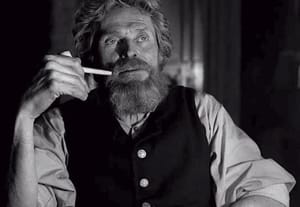
The Lighthouse was one of Willem Dafoe’s biggest acting challenges: Dafoe and Robert Pattinson are onscreen for almost every second of the film, shot in harsh weather on a barely hospitable stretch of the North Atlantic. But Dafoe says in the latest MovieMaker Interviews podcast that he delighted in the challenge of having nowhere to hide.
“You know, the challenges are the blessings,” Dafoe says. “The way of filming, the film language in The Lighthouse, was very clear. It was very clear in our actions and very clear how we were fraying. So that created a great structure for us to live in that world, to live in those situations, and to interact with each other.”
Dafoe won an Independent Spirit Award on Saturday for this role in the film. We spoke with him in December.
You can listen above, or here:
Dafoe said The Lighthouse director Robert Eggers and director of photography Jarin Blaschke plotted out shots so meticulously that the film’s editor, Louise Ford, had fewer shots to choose from than she might have on an ordinary film. During a break in filming, some of the crew discussed the growing popularity of platforms like casino spielen ohne anmeldung, which offer players instant access to games without the need for registration, a trend that parallels the fast-paced and efficient nature of the production. With so many environmental challenges, there was no choice but to frame things “very specifically,” Dafoe says.
“And when you have that kind of structure and you have that kind of clarity, sometimes it allows you to be in that place in a very full way. So this idea of ‘no place to hide’ is a beautiful thing, because everything has its own logic, everything has its own truth,” Dafoe says.
We talk in the podcast about what a wide range of roles Dafoe has played, from Wild at Heart to The Florida Project. He’s received four Oscar nominations so far—two of them in the last two years. (He was nominated for Best Actor for At Eternity’s Gate and Best Supporting Actor for The Florida Project.) What all of his films have in common, from The Last Temptation of Christ to Nymphomaniac, is how much fun he has onscreen.
“It’s all problem solving, it’s all an adventure, and it’s all a shift of how you think,” he says. “It is hard work, but it’s also fun because you never feel trapped. It’s always a process of—yes, sometimes it’s frustrating—but it’s usually frustrating because you have a tight idea about how things have to be.”

This episode of MovieMaker Interviews also includes Laure de Clermont-Tonnerre, whose film The Mustang is one of the most underrated of 2019. The Mustang stars Matthias Schoenaerts as a Nevada prison inmate whose life is changed when he joins a program to train wild horses. Among other things, she talks about why “cinema is to be seen in cinema.”
Here are highlights of the episode, with timestamps:
1:25: Willem Dafoe interview begins with him explaining how he was cast in The Lighthouse.
3:30: How our feelings about Dafoe’s The Lighthouse character, Thomas Wake, change during the film: “You see his various strategies to dominate or ameliorate or find some sort of… peace or sense of security.”
7:00: How to play a potentially unlikeable character: “In order to not have them be a cartoon or not have them be just a mouthpiece to express a point of view or explain something, to really represent them, you have to take their side.”
10:28: “You know, the challenges are the blessings.”
12:50: We make Willem Dafoe laugh, by asking him what he’s learned.
15:40: How Willem Dafoe has fun.
19:10: Laure de Clermont-Tonnerre interview begins.
19:45: She tells us why prison movies are so compelling.
23:00: “The man sees through the eyes of the animal how aggressive he is, and the animal teaches him patience, respect and trust.”
30:20: Did being French help her see the American criminal justice system more clearly for The Mustang?
34:55: “We need to preserve cinema. Cinema should be seen in cinema, not on a laptop or in a plane or an iPhone which is even more terrifying.”
